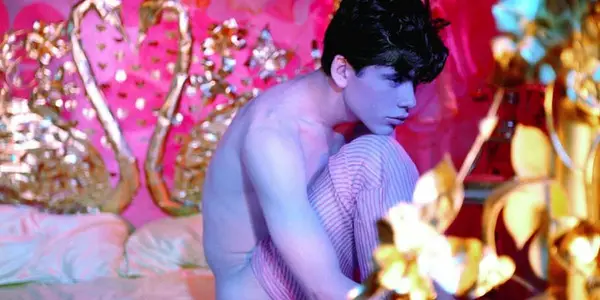I’ve always been astounded by the work of film restorations, which to me feels like the closest thing to actual magic and miracle that we have in the mortal world. When I saw clips of Ousmane Sembene’s Borom Saret in its youtube upload print and restoration side by side, it was pretty staggering. It sent a jolt of hope and enthusiasm in my veins that seems to come rarer and rarer nowadays. The same can be said for films that were discovered by miracle like Mohammed Reza Aslani’s Chess of the Wind which supposedly was randomly discovered in a closet after having thought lost for decades. The new restoration of James Bidgood’s Pink Narcissus is an event that should be making bigger waves than it is but predictably like most of these sorts of things, the realization of a restoration or discovery’s landmark importance is much delayed.
An Unparalleled Vision Done in Close Quarters
Bidgood’s Pink Narcissus isn’t just a miracle story for its restoration, it’s a miracle in its own creation as well. Filmed almost exclusively inside of Bidgood’s own small apartment, the movie seems to have an infinite expanse of time and space. It’s almost impossible to think that these images, the glowing beads and strobing lights and rainy New York City corners and Roman throne rooms were all filmed inside an apartment. His mastery over color, set decoration, and editing transform this movie into something that feels epic in both scope and vision. There’s infinitely greater amounts of imagination and magic conjured here than the hundred thousand square foot studio sets of Hollywood.

Explosive Imagination
The film takes us through the visions of one very horny gay man (Bobby Kendall) who sees himself as a matador taunting a stand-in from Kenneth Anger’s Scorpio Rising to a sex slave for a Roman Emperor (both roles being played by Kendall) and an Arabian prince witnessing a belly-dancing male whose large erect penis swings wildly as he moves. The film’s approach to sexuality is heavily stylized, but is much more explicit than many films of the past, especially Anger’s, which rely heavily (out of necessity) on innuendo. Bidgood has the privilege this time of being very clear about desire and he uses it in explosive fashion. His use of several male-exclusive spaces like bathrooms with urinals helps to set the stage of the kinds of fantasies his central character imagines. There is a sense of epic form to this film that encompasses the essence of cinema, that one’s imagination can take us to places far reaching in both time and space even if we’re not physically going anywhere.
Conclusion
There’s a conundrum that infiltrates film culture to a large degree today especially in the case of authorial intent and access to films. Bidgood never intended for Pink Narcissus to exist. The film was released with an “Anonymous” credit for director and led to speculation and rumor that Andy Warhol was actually the creator. Bidgood finally acknowledged his involvement in the film’s creation much later but it goes to question whether this restoration and people’s curiosity of the film as a rare ‘holy grail’ could only come against an artist’s wishes. In these cases, is access to art and cinema the be all end all argument or must we respect the wishes of the creator in regards to access itself? What I can say about Pink Narcissus is that I’m glad it exists, I’m glad its out there, and I’m glad Bidgood finally acknowledged artistic ownership. It’s a film that is of such creative and inspirational importance, a literal relic of possibility in the realm of the visual image, that an entire course on filmmaking could be taught using only it as a singular example.
Pink Narcissus 4K restoration screened at Metrograph NYC on April 1st.
Does content like this matter to you?
Become a Member and support film journalism. Unlock access to all of Film Inquiry`s great articles. Join a community of like-minded readers who are passionate about cinema - get access to our private members Network, give back to independent filmmakers, and more.